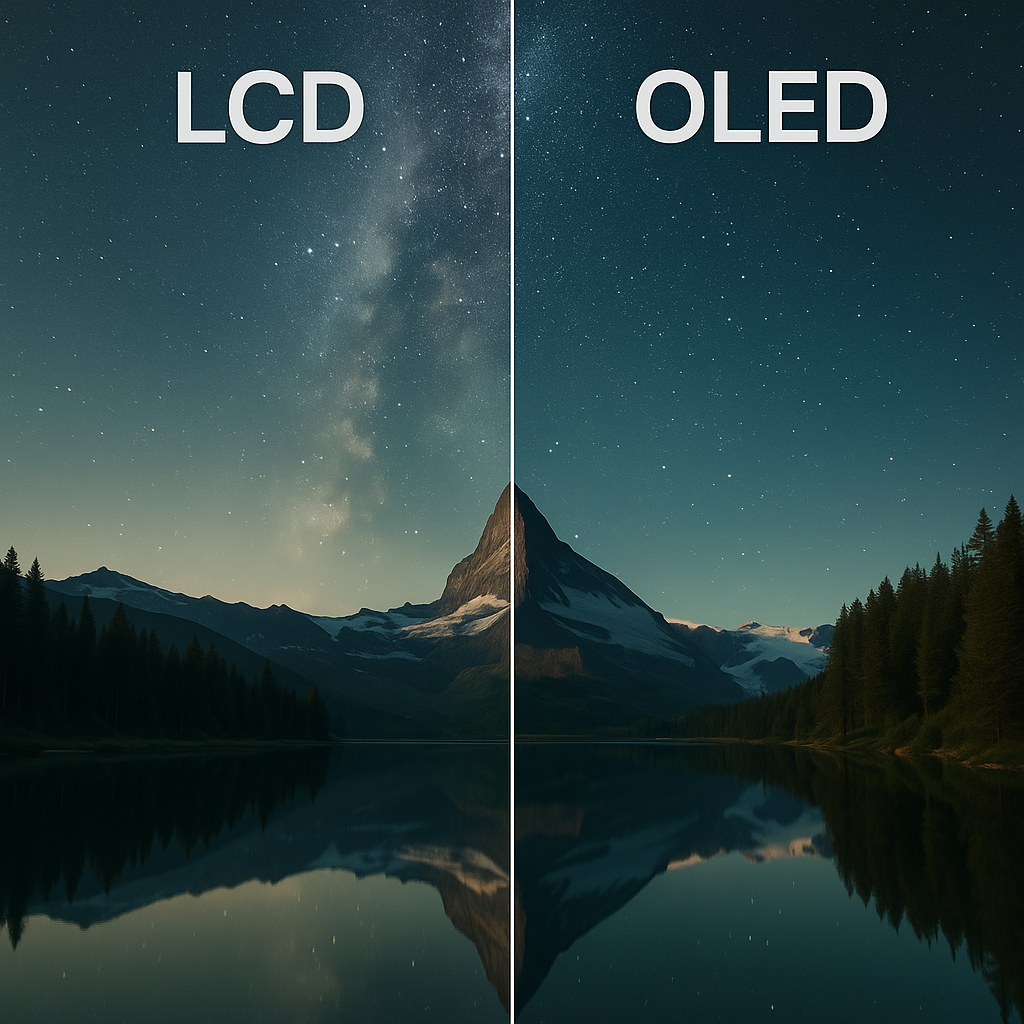Many people think OLED and LCD just look different, but their technology changes how they perform in real life. Picking the wrong one could lead to lower product value or user complaints.
OLED displays use self-emitting pixels for deeper blacks and vivid colors, while LCDs use backlighting for stable brightness and lower cost.
I remember when a client from North America insisted on OLED for a budget device. The display looked stunning—but cost and lifespan became big issues later. That’s when I realized: knowing the technology is everything.
OLED vs LCD, What’s the Difference?
OLED and LCD may both show images, but they work in completely different ways.
OLED creates images by lighting up each pixel individually; LCD uses a backlight that shines through layers of filters.

The technology behind the screen
OLED (Organic Light Emitting Diode)
- Self-emissive: Each pixel lights up on its own.
- No need for backlight: Allows ultra-thin, flexible displays.
- Perfect black: Pixels can completely turn off.
LCD (Liquid Crystal Display)
- Requires backlight: Usually LED-based.
- Needs liquid crystal layer: Controls how light passes through.
- Layered structure: Includes polarizers, glass, and filters.
Quick Summary Table:
| Feature | OLED | LCD |
|---|---|---|
| Light source | Self-emitting | External backlight |
| Black level | True black | Greyish black |
| Thickness | Thinner | Thicker |
| Flexibility | Yes (can bend/curve) | No (rigid glass) |
| Power Efficiency | Efficient on dark content | Efficient on bright UI |
OLED vs LCD – Who is better at contrast, brightness, viewing angles, and lifespan?
Let’s break it down by each feature that matters most to end users.
OLED wins in contrast and viewing angles; LCDs win in brightness and lifespan.
Feature-by-feature comparison
🌓 Contrast Ratio
- OLED: Infinite contrast. When pixels turn off, they’re pitch black.
- LCD: Limited contrast because backlight always leaks some light.
☀️ Brightness
- LCD: Can be much brighter, especially for sunlight-readable applications.
- OLED: Struggles with outdoor visibility under direct sun.
👀 Viewing Angles
- OLED: Almost perfect from every angle.
- LCD: Loses color and brightness when viewed off-axis (especially TN type).
⏳ Lifespan
- LCD: Typically lasts longer, stable over time.
- OLED: Organic materials degrade, especially blue pixels (burn-in risk).
🔋 Power Consumption
- OLED: Efficient in dark-mode apps; inefficient with white backgrounds.
- LCD: Constant backlight = constant power, more predictable.
| Feature | OLED | LCD |
|---|---|---|
| Contrast Ratio | Excellent | Moderate |
| Brightness | Moderate | Excellent |
| Viewing Angles | Excellent | Moderate to Good |
| Lifespan | Shorter (risk of burn-in) | Longer and more stable |
| Power (Dark UI) | Low | High |
| Power (Bright UI) | High | Stable |
We had a customer from India using OLEDs in smartwatches. The first batches looked great, but complaints of screen burn-in came within months. We switched to IPS LCDs—and the returns dropped.
OLED vs LCD – Which Display Is Right For Your Application?
Every use case has different needs. There’s no “one-size-fits-all.”
Choose OLED for premium, color-rich displays; choose LCD for durability, brightness, and low cost.
Application-based decision
When to choose OLED:
- Devices with dark UI (smartwatches, phones)
- High-end products needing visual wow
- Thin or curved screen requirements
- Short-term or disposable devices
When to choose LCD:
- Products exposed to sunlight
- Industrial or rugged devices
- Devices with static content (to avoid OLED burn-in)
- Budget-sensitive projects
| Application Type | Recommended Display |
|---|---|
| Smartphone | OLED or IPS LCD |
| Medical equipment | IPS LCD |
| Smartwatch | OLED (short term) |
| Vending machine UI | LCD |
| Automotive dashboard | IPS LCD |
| Wearable with curved edge | OLED |
A customer in Brazil chose OLED for a new fitness tracker. But when the product moved into mass production, they switched to LCD because OLED yields were too low and costs too high.
Things to consider before choosing an OLED or an LCD
Beyond specs, think long term: usage, environment, supply, and assembly complexity.
Make sure you factor in durability, total cost, supplier availability, and production requirements before deciding.
Four practical questions to ask
1. How will the user interact with the screen?
- Dynamic videos? OLED gives better response.
- Static images or menus? LCD is safer.
2. Is the product used indoors or outdoors?
- OLED struggles in direct sunlight.
- LCD with high brightness is better outdoors.
3. What is the expected product life?
- OLED can fade or burn in after 1–2 years.
- LCD can last 5+ years in stable condition.
4. What’s the budget and volume?
- OLED costs more per unit, especially in low-volume runs.
- LCD has stable pricing and larger supply chain.
When my company advises customers, we also check the availability of matching drivers and connector compatibility (FPC, pin, etc.). Even a perfect panel won’t work if the connector doesn’t fit your design.
Conclusion
OLED looks stunning; LCD lasts longer. Choose the one that matches your real-world need.

